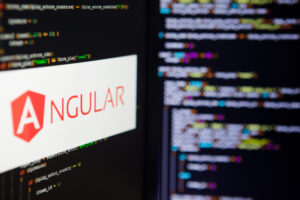
Legacy software refers to outdated applications based on obsolete technology and standards. Avoiding legacy software is typically very difficult; it’s the result of past technology choices.
Outdated applications do pose a growing problem for many companies. Applications should be able to last for decades, but in practice, they are only modern for three years and can then be considered legacy for the rest of their lifespan. This while the application often support a business-critical processes.
Definition: A legacy system is outdated computing software and/or hardware that is still in use. The system still meets the needs it was originally designed for, but doesn’t allow for growth.
In the ever-evolving landscape of technology, business technology stakeholders face a critical decision when it comes to their legacy systems: evolve or replace?
The digital ecosystem is marked by a constant flux of advancements, making it critical for organizations to adapt and stay competitive in an ever-advancing technology landscape.
Once critical modern software systems have quickly become legacy software systems, once the backbone of operations, are now often perceived as bottlenecks hindering innovation and efficiency.
However, the decision to overhaul these systems is not one to be taken lightly. The dilemma lies in striking a balance between preserving the familiarity of established systems and harnessing the potential benefits of cutting-edge technologies.
We’re going to explore the intricacies of continuous optimization as opposed to the complete replacement of legacy systems.
What factors do you need to consider when making systems design decisions?
What are the challenges and opportunities associated with each approach?
We’re going to dissect the nuances of this tech challenge and provide insights to help businesses like yours chart a course toward a future-proof digital infrastructure.
Understanding Evolution vs. Replacement for Legacy Systems
The push for innovation, efficiency, and scalability in today’s competitive markets has led many businesses to evaluate the role of their legacy systems. On one hand, these systems are often deeply ingrained in the organization’s processes and workflows, providing a sense of stability and familiarity. On the other hand, they may lag behind in terms of compatibility with modern technologies, limiting the organization’s ability to capitalize on emerging trends such as publi, private or on-prem cloud computing, artificial intelligence, and advanced analytics.
Your decision to evolve or replace a legacy system is multifaceted, involving considerations ranging from budget constraints and resource availability to the potential impact on day-to-day operations.
Continuous Optimization vs. Complete Replacement
Continuous optimization, involving incremental updates and enhancements to the existing system, offers a path to modernization without the upheaval of a complete overhaul. However, it requires a nuanced understanding of the system’s architecture and may have limitations in addressing fundamental structural issues.
On the flip side, complete replacement promises a fresh start with the latest technologies and a clean slate for streamlined processes. Yet, this approach comes with its own set of challenges, including significant upfront costs, potential disruptions during the transition, and the need for comprehensive staff retraining.
As you and your organization grapple with this decision, it becomes crucial to weigh the pros and cons of each approach in the context of their unique business objectives, industry demands, and long-term strategies.
With the challenge of keeping pace with the rapidly changing demands of the digital era, comes a question. Is it more advantageous to embark on continuous optimization or embrace the prospect of a complete system overhaul?
The Case for Continuous Optimization
Cost-Effectiveness
One of the most compelling reasons to opt for continuous optimization is the cost factor. Replacing an entire legacy system can be a monumental financial undertaking, involving not just the cost of new software and hardware but also the expenses associated with data migration, employee training, and potential downtime. Continuous optimization allows for a gradual and targeted approach to addressing specific pain points without the need for a massive upfront investment.
Minimized Disruption
Ripping out and replacing a legacy system is akin to performing open-heart surgery on a business. The risks of operational disruptions, data loss, and workflow interruptions loom large. Continuous optimization, on the other hand, allows for a more surgical approach. It enables organizations to make incremental improvements while keeping the system running, minimizing disruptions and ensuring a smoother transition.
Preservation of Intellectual Capital
Legacy systems often hold a wealth of institutional knowledge and business logic that has been accumulated over the years. These systems are a repository of the unique processes and practices that make a business tick. Continuous optimization allows for the preservation of this intellectual capital, preventing the loss of critical insights and ensuring a seamless transition for employees who are already familiar with the existing system.
Adaptability to Changing Requirements
The business landscape is in a constant state of flux, with new technologies and market trends emerging regularly. Continuous optimization allows legacy systems to adapt to these changes incrementally. It provides the flexibility to integrate new functionalities, enhance security measures, and meet evolving compliance standards without the need for a complete system overhaul.
When to Consider Replacement
While continuous optimization offers a host of benefits, there are instances where the scale of transformation required may necessitate a more radical approach – system replacement. Here are a few scenarios where opting for a new system might be the more prudent choice:
Obsolete Technology
If a legacy system is built on outdated technology that is no longer supported or compatible with modern tools, the cost and effort required to maintain it might outweigh the benefits. In such cases, a strategic replacement can future-proof the organization and pave the way for long-term success.
Scalability Challenges
Businesses experiencing rapid growth may find their legacy systems struggling to scale efficiently. In such scenarios, a new system designed to handle increased data loads and user demands may be the key to unlocking the full potential of the organization.
Strategic Alignment
As businesses evolve, so do strategies and objectives. If a legacy system hinders rather than facilitates the achievement of these goals, a replacement system is in order. Aligning the technological infrastructure with the broader business strategy is crucial for sustained success.
As technology evolves at an unprecedented pace, businesses must decide between continuous optimization and outright replacement. This decision is not without its challenges, as each path comes with its own set of pain points.
Cost Constraints
Budget constraints will always limit the extent to which legacy systems can be optimized. Incremental improvements may be financially viable, but the overall cost-effectiveness can be questionable.
Disruption and Downtime
Making gradual improvements to a legacy system allows for minimal disruption. However, the risk of prolonged downtime during updates or fixes is inherent, potentially impacting productivity and customer satisfaction.
Continuous Optimization
Legacy systems often have intricate integrations with various components. Continuous optimization might face hurdles when trying to seamlessly integrate new technologies or features without causing conflicts.
Legacy Expertise
Continuous Optimization: As technology advances, finding skilled professionals well-versed in legacy systems can become a challenge. This scarcity may hinder the optimization process and limit the scope of improvements.
Risk Mitigation
The risk of system failures or security breaches persists with legacy systems. Continuous optimization may not eliminate these risks entirely, potentially leaving the organization exposed to vulnerabilities.
In the grand symphony of technological evolution, the choice between continuous optimization and system replacement is not a binary one. It’s a decision that requires a deep understanding of the organization’s current state, future goals, and the intricacies of its legacy systems. By embracing continuous optimization, businesses can orchestrate a harmonious blend of innovation and preservation, ensuring that their legacy systems not only survive but thrive in the dynamic landscape of the digital age.
The Mantrax Software Solution
At Mantrax Software Solutions, we understand the delicate balance organizations must strike to stay ahead in the ever-changing digital landscape. Our expertise lies in guiding businesses through this decision-making process, offering tailored solutions that align with their unique objectives and industry demands.
As you stand at the crossroads of evolution and transformation, Mantrax is here to be your strategic partner. Our commitment to excellence and proven track record in developing future-proof digital infrastructures make us the ideal companion on your journey toward technological advancement. Whether you choose the path of continuous optimization or opt for a system replacement, we provide the expertise and support needed to seamlessly integrate cutting-edge technologies into your operations.




